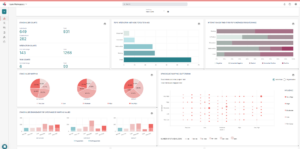How An SRM Can Improve Your Stakeholder Experiences

Companies that focus on improving customer experience tend to perform better — but are there similar benefits to optimizing the stakeholder experience?
The short answer is yes! And one of the best ways to help stakeholders have a positive experience with your organization is by using a stakeholder relationship management (SRM) tool like Simply Stakeholders.
So, let’s talk a bit about what stakeholder experience is, why it matters, and how an SRM can help.
What is Stakeholder Experience?
Stakeholder experience refers to how stakeholders feel about their interactions with your organization — whether positive, negative, or neutral. Each interaction impacts their overall impression of your company and whether they continue to engage with you (or not).
The key dimensions of stakeholder experience are trust, relationships, and value share. With organizations that work to add value, increase trust, and improve relationships will likely improve their overall stakeholder experience.
Why Does It Matter?
Stakeholder experience matters because when it’s good, you are more likely to get other good outcomes, like:
- Recruiting more stakeholders to your list who are willing to receive communication and participate
- Encouraging stakeholders to keep opening emails, filling out surveys, and attending your events
- Building familiarity and trust with your brand
- Build stronger stakeholder relationships
- Increasing response rates, which means more feedback and perspectives to help inform your decisions
- Motivating stakeholders to stay in touch for potential projects in future
And the above benefits can increase the likelihood of a successful engagement and project.
Why Does It Matter Right Now?
This might be the first time you’re hearing about and considering the stakeholder experience, but it likely won’t be the last. Stakeholder experience is becoming increasingly important.
Even if your organization has successfully recruited and engaged with stakeholders in the past, it’s a good idea to review (and continually improve) your stakeholder experience because stakeholder expectations are changing. This is due to a number of factors, but perhaps the two major ones are:
- Demand – Growing demand for stakeholder input means that if your consultations don’t stand out, you’re less likely to get engagement
- Technology – Newer technologies are enabling more ways to engage with stakeholders
To encourage stakeholders to engage with your organization, you may need to go beyond what was previously acceptable and consider how you can make the experience more convenient, personalized, relevant, and even fun.
Fortunately, if you have the right tools on hand, there are plenty of steps you can take that will almost instantly give your stakeholder experience a lift…
How SRMs Can Impact the Stakeholder Experience
Understand Your Stakeholders

A lack of understanding can be a source of conflict when interacting with stakeholders. On the other hand, a richer understanding can help you engage stakeholders in a way that’s most relevant and effective for them — and help you manage or avoid conflict. For the best possible stakeholder experience, it’s important to learn as much as you can about your stakeholders.
The right SRM will do more than just record your stakeholder list and their contact info. Inside Simply Stakeholders, you can use custom fields to add any characteristics you’d like to stakeholders, like:
- Location
- Role
- Organization
- Education level/institution
- Cultural/religious affiliation
- Disability accommodations required
- Property type
- Preferred contact methods
- Plus, anything else relevant to your project
From there, you can analyze your stakeholders to identify trends, map them based on things like interest/impact/influence, and prioritize the stakeholders you need to engage with the most.
Communicate Sooner and More Frequently
You’ve probably heard of the stakeholder engagement best practice to begin your consultation early and consult often — and this can play a role in stakeholder experiences, too.
If you engage stakeholders early on in the process, it means you get the chance to make a good first impression. And they get the opportunity to hear about projects and decisions directly from you (rather than the media or neighbourhood grapevine).
Plus, the earlier on you engage people, the more likely they’ll get the chance to genuinely impact project outcomes. This helps to build mutual trust and respect, and shows stakeholders that your intentions are genuine. In other words, you’re not just in it to make your organization look good.
It’s also important to keep your stakeholders in the loop with regular communication, as this will demonstrate that you’re reliable, consistent, and not hiding anything.
Inside your SRM, you can see a history of when your team last engaged with each stakeholder (and the issues you need to update them on). This can help you identify which stakeholders you need to communicate with next, whether anyone has fallen out of the loop, and make sure nobody gets left out.
Engage In Conversation
A genuine, productive stakeholder engagement involves two-way communication and collaboration. In other words, prepare yourself for back-and-forth conversation. But managing this kind of engagement can be tricky when you have multiple stakeholders, unless you have the right tools in place.
Simply Stakeholders offers useful features to support back-and-forth communication, like email integration, SMS integration, survey integration, and notes. This allows you to track every interaction in one place. Historical data like this means that you (and your team members) have a rich context to inform future interactions that:
- Ensures your responses are relevant and informed
- Avoids stakeholders having to repeat themselves
- Creates a feeling of continuity between conversations (even across multiple platforms or with different people on your team)
This is one way an SRM can help you manage the tiny details that make a big difference to the stakeholder experience.
Gather Feedback and Respond Promptly
Nobody likes unresolved issues or questions. In fact, one of the top frustrations for customers (which is likely to be similar for your stakeholders) is having to wait for answers or responses.
An SRM empowers your team to not only gather feedback, but respond more efficiently to questions and take action on feedback.
Simply Stakeholders allows you to easily generate feedback forms, surveys, and polls, embed them on your website, and collect the data directly into your stakeholder system. Because the data is automatically attached to the correct contact in your system, you can respond faster than ever.
The integrated email and SMS functionalities support faster replies, too. With everything in one system, team members have visibility across stakeholder communications at all times, allowing them to track open conversations and share responsibility for following up.
Stay On Task

It’s important to do what you say you’ll do so that stakeholders know you can be trusted. An SRM with built-in task management can help you and your team keep on top of tasks by:
- Tracking issues
- Managing grievances
- Following up in a timely manner
- Recording commitments
- Seeing context around tasks (interactions, issues, and grievances)
- Collaborating on tasks
- Taking action as promised
Personalize Experiences
The more you can tailor your communication and approach to each stakeholder, the better experience you can offer. In other words, stakeholders will respond best when you engage them on the issues that are most relevant to them via the communication method and platforms they most prefer.
A powerful SRM like Simply Stakeholders can help you personalize stakeholder experiences in three main ways:
- Mapping – Group stakeholders based on similar issues or preferences for efficient management (and tailored communication to each group)
- Analysis – Determine which stakeholders you should connect with personally (through a phone call, face-to-face meeting, or similar)
- Recordkeeping – You can reference historical data on each interaction to personalize your emails, phone calls, and conversations with stakeholders
Reduce Friction
Not all SRMs are equal when it comes to the stakeholder experience — even the smallest details can make a difference. Look for features like:
- Brand customization (your stakeholders should see your brand on forms, surveys, and emails — not the brand of the SaaS tools you use)
- Mobile friendly design
- Intuitive interface
- Integrations (so that stakeholders don’t have to manage multiple logins/platforms)
- Easy subscription management (from sign up to unsubscribe)
Anything that removes friction and makes life easier for your stakeholders can support a better overall experience.
Be More Human

A lack of human interaction can leave stakeholders feeling like just another cog in your consultation machine. Although a stakeholder tool is designed to automate many of your processes, it can also free up your team to engage with some stakeholders on an individual basis. With a bit of free time, you can create a stakeholder experience they won’t soon forget.
Measure Your Stakeholder Experience
You could use your SRM’s survey tools to get direct feedback on the stakeholder experience by asking for a satisfaction rating like this:
How satisfied were you with this update/event/survey (where 1 is least satisfied and 10 is most satisfied)?

Or you could ask a question like this:
| How likely are you to recommend our organization to a friend, family member, or colleague?
⭘ Very unlikely ⭘ Somewhat unlikely ⭘ Somewhat likely ⭘ Very likely |
Over time, the responses can help you measure whether the changes you make to an experience lead to greater satisfaction.
Analyze Stakeholder Experience Trends
You could also use the built-in sentiment analysis tool to help determine how stakeholders feel overall or after specific interactions. Or look at what happened before stakeholders stopped engaging. This can provide insights into which steps in your stakeholder journey aren’t working well so that you can optimize them first. Plus, insights into whether certain stakeholder groups respond better to some experiences than others.
Optimize Your Stakeholder Experiences with Simply Stakeholders

Ready to take charge of your stakeholder experience and manage stakeholders like never before? A powerful stakeholder relationship manager like Simply Stakeholders can get you there sooner, with insights and tools designed to help your team engage more effectively.
Explore Simply Stakeholder’s features or contact our team to book a demo



































